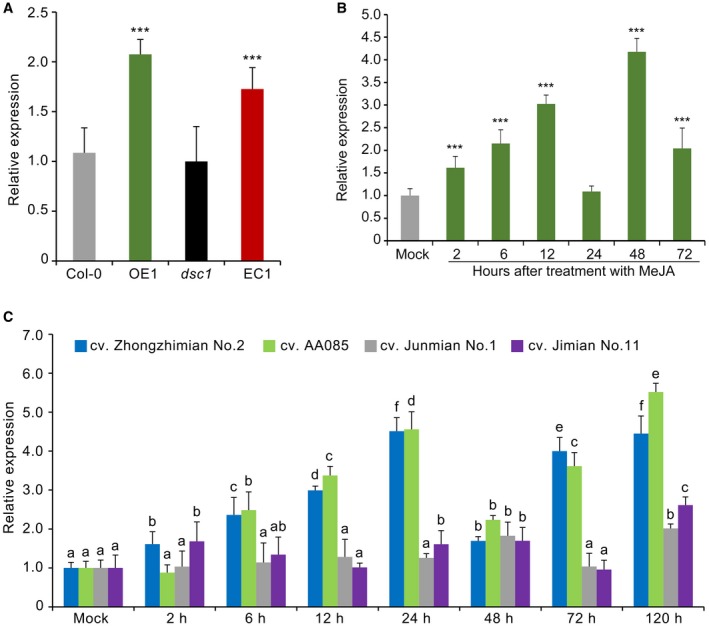Figure 7.

GhDSC1 and GhCAMTA3 show similar expression patterns in cotton. (A) Expression analysis of GhCAMTA3 in the GhDSC1 overexpression transgenic line (OE1), the dsc1 mutant, transgenic lines of dsc1 mutant in which GhDSC1 was introduced (EC1), and wild‐type Col‐0. The respective plants were inoculated with a conidial suspension of 5 × 106 conidia/mL of Verticillium dahliae (strain Vd991) using a root‐dip method. Leaf samples were collected 72 h after inoculation. The transcript relative expression was assessed by Reverse Transcription‐quantitative Polymerase Chain Reaction (RT‐qPCR) using the comparative threshold 2‐∆∆CT method and the Arabidopsis thaliana UBQ5 as a reference. Values represent averages of three independent biological replicates. Error bars represent standard errors. Double asterisks (∗∗) represent statistical significance of P < 0.01, according to an unpaired Student's t‐tests between dsc1 mutants, EC1 and OE1 plants compared with the wild‐type (Col‐0). (B) Expression of GhCAMTA3 in response to MeJA treatment. Transcript levels of GhCAMTA3 were detected in RNA samples from 3‐week‐old cotton plants (cv. Zhongzhimian No. 2) treated with 10 mM MeJA. Asterisks (∗∗) and (***) represent statistical significance at P < 0.01 and P < 0.005, respectively, according to unpaired Student's t‐tests between treatment groups compared with the control group (Mock). (C) Expression analysis of GhCAMTA3 in four cotton cultivars after inoculation with V. dahliae strain Vd991 by RT‐qPCR. The samples of four cotton cultivars were treated as in detection of the expression of GhDSC1. Relative expression analyses of GhDSC1 by RT‐qPCR were performed using the cotton 18S gene as reference using the comparative threshold 2‐ΔΔCT method. Values represent the averages of three independent biological replicates of three plants each. Error bars represent standard errors. Different letters indicate significant differences at P < 0.01 based on Tukey's HSD.
